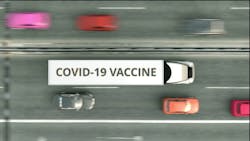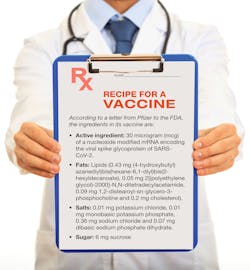Speed Bumps on the Road to Delivering COVID Vaccines
Editors Note: Over the course of this week, Machine Design will be sharing a series of articles addressing the development and distribution of the COVID-19 vaccine—and the obstacles surmounted along the way. Be sure to check out the other installments below:
- Manufacturers Were on Point in the Race to a Vaccine
- Global Manufacturers Fine-Tune Strategies
- COVID Vaccine Moves to the Front of the Supply Chain
- Thanks for Sharing: Reusable Open Source Hardware Respirators
The U.S. healthcare system, with help from the rest of the government as well, is now in the process of vaccinating everyone in the U.S. against the COVID-19 virus, which takes two injections of vaccine given about three weeks apart. That means making, delivering and injecting more than 660 million doses.
Pfizer and Moderna have both developed vaccines, but delivering them to the network of planes and trucks—and maybe even drones—that will take them to where they can be deployed and used presents some engineering challenges.
Vaccine Differences
The Moderna and Pfizer vaccines are the first two of their kind to be approved for use. Until now, vaccines contained dead and weakened forms of the offending virus, its toxins or its surface proteins. They kickstart the patient’s immune system to start cranking out antibodies custom-made to attack and kill those agents, and hence prevent the patient from becoming dangerously infected in the future. Such vaccines can also help patients fight off viral diseases as well as prevent them from ever getting sick in the first place.
Both of the two new COVID vaccines use messenger ribonucleic acid (mRNA). This type of RNA is used to carry instruction on how to recreate proteins from the DNA protected inside the cell’s nucleus to the areas of the cell, the cytoplasm, where the protein will be made. Once the mRNA does its job, it quickly degrades.
For the vaccine, the mRNA carries instructions for building copies of the coronavirus’ spike protein, not the entire virus. Human cells read those instructions and produce copies of the protein which, in turn, prime the immune system to make antibodies that attack the coronavirus should it come calling. And because the vaccines contain no parts of the virus, just instructions (genes) for making the spike, patients theoretically cannot become infected from the vaccination. The mRNA also never enters a cell’s nucleus, so it cannot damage the patient’s DNA.
mRNA vaccines can also be manufactured quicker and less expensively that traditional vaccines because there is no need to use yeast or bacteria to make and purify the COVID spike’s gene. Developing the formula for mRNA vaccines is also more straightforward; researchers just need the genetic sequence of the pathogen to start making then testing the vaccine. For example, Moderna got a vial of COVID-19 virus from China in January of 2020, and they sequenced its genes in just a day. So within two days, the company had all it needed to design and design the vaccine.
In the vaccine, the mRNA is coated with a protective lipid shell that protects the mRNA from naturally breaking down until after it gets into cells to delivers its cargo. Then the immune response begins.
This is where the Moderna vaccine has an advantage. The company has already developed 10 mRNA-based vaccine candidates and has more experience in tailoring the lipid shell to best preserve the mRNA fragments. This means it can be safely stored for up to six months and shipped at −4°F (20°C) without degrading the mRNA. It also remains stable for up to 30 days if held at 36° to 46°F, the temperature of standard home or medical refrigerators.
This degree of refrigeration (−4°F) is common in today’s “cold chain,” the global logistical network of vehicles and warehouses used to transport and distribute drugs and other healthcare products as well as foods.
The Pfizer vaccine, however, has a different protective lipid shell and likely a different formula for its mRNA; it needs to be kept at −94°F (−70°C), beyond what the cold chain infrastructure usually handles. Fortunately, dry ice, with a surface temperature of about −110 °F (−79°C) can be used in packaging vials of vaccine and keeping it cold enough.
And both vaccines require patients get two doses about three weeks apart to get the full immunizing effect.
mRNA and Cold Temperatures
There are at least three factors that are suspected of determining how robust the mRNA vaccine is and much refrigeration it needs to remain active and effective. How pharmaceutical firms tackle those factors, which they are unlikely to reveal, then determines how cold the vaccines must be kept.
DNA and RNA differences: DNA has a molecular backbone of deoxyribose a sugar; RNA’s backbone is made up of ribose, a sugar with one more oxygen molecule than deoxyribose, making it much less stable than DNA. As a result, DNA can survive for generations while RNA is short-lived and transient.
RNA killers: Once mRNA does its task, transporting the genetic instructions for a protein from the DNA to where it’s needed in the cell, a cadre of enzymes in the cell and tissues breakdown the RNA relatively quickly. This helps control how much of a particular protein is made. Keeping the RNA cold slows the cell’s metabolism and stops the enzymes form breaking it down.
RNA Structure: DNA has a sturdy backbone structure consisting of two DNA woven into a double helix. NRNA’s is a single wandering strand that sometimes connects to itself and forms odd shapes or secondary structures. These structures make some forms of RNA more fragile than others.
Thermal Packaging
To keep its vaccine cold and viable during shipping and short-term storage, Pfizer developed a thermal shipper, or “cool box.” It's about the size of a carry-on suitcase. These boxes can keep the vaccine viable at −94°F ± 14°F (−70°C ± 10°C) for extended periods of time by using dry ice. The boxes are said to maintain that temperature for 10 days unopened which lets airlines and truckers distribute them globally. Once open, healthcare workers can use the boxes as a temporary storage up to 30 days if they are replenished with dry ice every five days.
If the boxes actually contain the dry ice, they will have to be vented to stop a buildup of CO2 gas as dry ice sublimates directly to a gas. It can build up pressure and rupture packaging if not released. Dy ice is also a hazard for workers loading and unloading it, as it can cause suffocation if the built up of CO2 gas is in an enclosed, unventilated space.
Each cool box contains a GPS-enabled sensor that continuously tracks its location and temperature. After the vaccine vials are thawed, can be safely stored for up to five days at 35°F to 46°F).
Pfizer’s cool boxes will also need batteries that can survive the frigid temperatures. One company, Tadiran, makes specially modified lithium batteries (lithium thionyl chloride, LiSOCl2) for use in the cold chain for temperatures down to −112°F. These bobbin-type batteries can be used in wireless sensors to continuously monitor the transport of foods, medicines, vaccines and tissue specimens frozen or packed in dry ice.
They feature a non-aqueous electrolyte adapted to Arctic temperatures and generate 3.6 V. They have twice the energy density of other lithium battery chemistries and have a service life of 20+ years. The batteries have a glass-to-metal hermetic seal rather than the more common crimped elastomer gasket as the seal better prevents battery leaks.
Certified and UL-recognized Tadiran cold chain lithium batteries are available in 1/2AA, 2/3AA, AA, C, D and DD cylindrical cells; wafer cells; and custom battery packs. In addition, Tadiran manufactures a complete line of 40-year LiSOCl2 batteries, including cylindrical, coin-sized and battery packs.
Logistics
Based on projections, Pfizer, working with BioNTech, could have supplied up to 50 million vaccine doses in 2020 and will send out over 1.3 billion doses by the end of 2021 (subject to manufacturing capacity and regulatory approval or authorization).
Pfizer is using five of its facilities to make the vaccines: They are located in St Louis; Andover, Mass; Kalamazoo, Mich.; Pleasant Prairie, Wisc.; and Puurs, Belgium.
The federal government announced last week that contracted for 100 million doses of Moderna’s vaccine for $1.5 billion and it is said it will contract for 100 million more. billion. Moderna is charging $32 to $37 per dose for some customers with larger-volume purchases qualifying for lower prices.
It seems that the most difficult part of the challenge is not necessarily that reliant on engineering: injecting those millions of doses into people across the U.S. and the globe and then ensuring they get two doses. Compounding the problem are the people refusing to get themselves or their children vaccinated. This could put a crimp in the push for herd immunity.
For More Information
● The initial wave of vaccine distribution.
● Background information on the Cold Chain distribution network.

